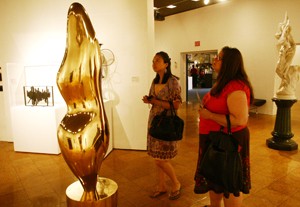What is an art medium that pops out at you and makes you walk around it to absorb the different moods that each side of it conveys? It is sculpture, and the UA Museum of Art is showcasing the best of its collection in “”Of Flesh, Form and Matter.”” While this exhibition certainly has its share of perky breasts and idealized forms, the greatest thing about sculpture is its interpretation of stillness in action. Most sculptures suggest movement with stagnant forms.
“”Sculpture is a three dimensional thing which takes advantage of space, it’s about positive and negative space,”” said Thomas Rossi, manager of Davis Dominguez Gallery. “”What makes a good sculpture is the way that the sculpture interacts with space.””
Luis Jimenez’ “”Man on Fire”” (1969) evokes the movement of fire with bright orange waves of flames that sparkle with golden flecks of glitter. Jimenez said of his work that, “”Man on Fire was an attempt to look back at my own Mexican roots. The ‘Man on Fire’ became a symbol of the Mexican Revolution for the muralists.”” Jimenez took this symbol and made it his own in the form of a Plexiglas man whose skin is erupting in fire. Inspired by political turmoil, Jimenez said, “”The very first studies that I did for Man on Fire were either black or Puerto Rican men with Molotov cocktails.””
While this exhibit has prototypical sculptural pieces like Barbara Hepworth’s “”Makutu (Opus 505)”” which is a bronze oval that looks like a weeble that wobbles but won’t fall down, it also has contemporary sculptures. Newer sculptures have taken the medium to a whole new level and these pieces are exciting, provoke curiosity and oftentimes toe the border between decency and vulgarity.
Nancy Grossman took black patent leather and zippers to create her sculpture, “”Caracas”” (1971), which evokes noise. A sculpted patent leather face has a wide open mouth and he looks like he is screaming in agony but for some reason you can’t hear his cries. His pained features show him struggling against his zipped-shut eyelids, forehead and cheeks.
Of course, no sculpture exhibition would be complete without an Alexander Calder. The museum also shows off its big name pieces with Claus Oldenburg’s tiny “”Times Square Figure”” and small Picasso sculptures of a hand and a faun with a giant erection.
Anne Truitt’s “”Summer Treat”” (1965) is a simple minimalist square pillar but it suggests that it is more than that with its pale orange coloration. It is reminiscent of an orange creamsicle – especially since the bottom five inches are a lighter shade of yellow-orange. Its solid faÇõade also suggests a giant chunk of cheddar cheese. Minimalist sculptures like this leave room for playful, free interpretation.
Edward Kienholz’s “”Sawdy”” (1991) is a sculpture that is a little more spelled out for the reader. Kienholz’s piece is an old Datsun door that hangs on the wall next to a license plate that reads “”SAWDY 25″” with the word “”Brotherhood”” in small letters at the top where the state should be. Resin has been poured down the door and it evokes a feeling of dirty stickiness with its shape of a dripping clear substance. An illuminated screen-print lies in the window frame and the audience is a powerless bystander, looking at the photo of masked men beating up a black man. Their cars with bright shining headlights encircle them, giving the effect of being an onlooker inside of one of the cars in the circle.
George Segal’s “”Man Looking Through Window”” (1980) is an almost creepy example of sculpture that looks like it is about to walk away. Segal created a wooden window frame with bricks underneath it that stands in front of a plaster man whose eyes are shut. He wears a frown and is holding his hands together in front of him like he is agitated. The entire scene is white and you can clearly tell that the man is made from plaster, but his lifelike form makes the viewer expect the man to open his eyes and start letting out a melancholy whimper.
“”The advantages of sculpture are that the viewer can interact with the sculpture in a three-dimensional way,”” Rossi said. “”The disadvantages are that very few collectors buy sculpture. It is a limited medium because less of it is created since less of it is collected.””
An exhibition of such variety and quality is a rare find. Pieces from the early nineteenth century to today fill up the museum and breathe fresh life into ordinary conceptions of what sculpture should be. It’s not just alabaster ladies and Madonnas; this exhibition also shows the edgier side of sculpture.









